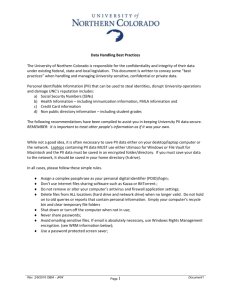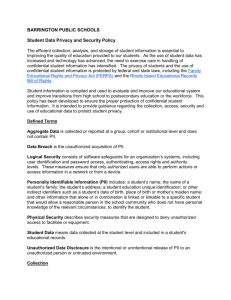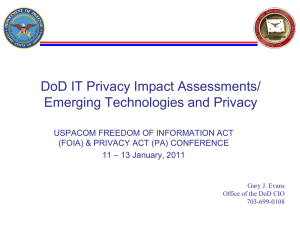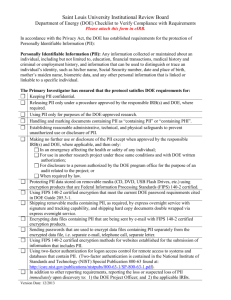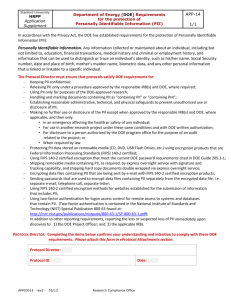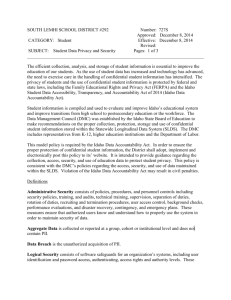Privacy at DHS: Protecting Personal Information
advertisement
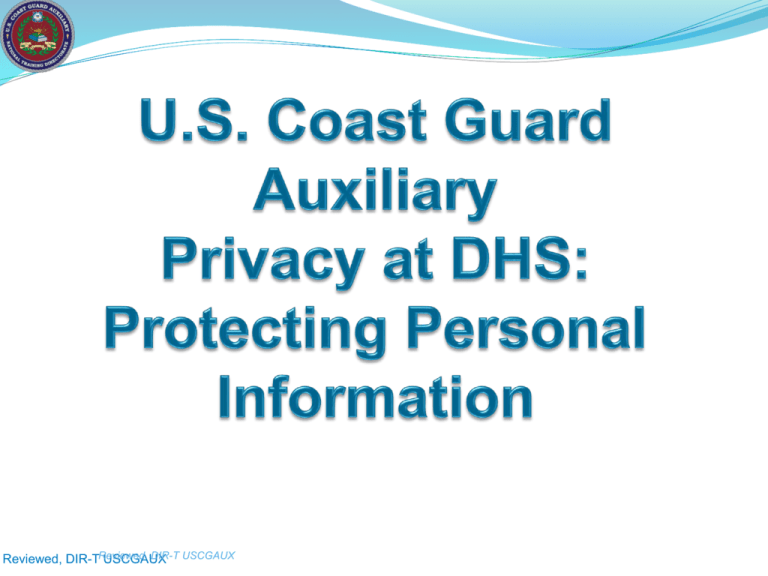
DIR-T USCGAUX Reviewed, DIR-TReviewed, USCGAUX Reviewed, DIR-T USCGAUX Introduction • Hi, I'm the DHS Privacy Man. For the next 15 to 20 minutes, I want to talk to you about the importance of safeguarding personal information, such as Social Security numbers, that DHS may collect or store in its databases or in paper files. Congress and OMB have mandated privacy training for both employees and contractors at all federal agencies to help staff identify and mitigate privacy risks related to sensitive personal information, which I will define in a moment. Reviewed, DIR-T USCGAUX Objectives • In our mission to secure the homeland, DHS needs to collect information, At the end of this personal course, you should be also able known to: as Personally Identifiable Information or PII, from Define Personally Identifiable (PII). citizens, legal residents, andInformation visitors, and we are obligated by lawconsequences and DHS policy this PII. List the potential of to notprotect protecting information to prevent identity theft or other Discuss required methods for collecting, using, adversethe consequences of a privacy incident or sharing, and safeguarding PII, and misuse of data. As DHS staff who might collect, use, orany share PII, youor need to: Report suspected • Know howprivacy to protect PII; and confirmed incidents. • Report any suspected or confirmed The audio will resume on privacy incidents. screen 5. Reviewed, DIR-T USCGAUX Privacy is Embedded into Our Mission IfBefore you are program your manager wea discuss role or in system owner, it is important to understand your responsibilities for protecting privacy privacy compliance at DHS, letdocumentation me tell completing you about framework weoperational. use to before your the system becomes assess privacy risks associated with Depending onthe the need nature of your system or of, anyAssess new technology at DHS that •program, for, and scope privacy compliance documentation such collects PII. as aany Privacy Impact Assessment, required by the Ecollection of PII, and… Government of Fair 2002, and/or a System of We use the Act DHS Information Records Notice, required by theas Privacy of 1974, •Practice Embed privacy protections in the Principles or FIPPs our Act may be required. framework for identifying and Information Technology system at Although this course will not get into the mitigating privacy risks. When new details of the front-end. how to prepare these documents, it is to important to systems are developed or updated recognize that privacy compliance gaps can put collect PII, staffatinrisk. the •your We askprivacy system development system orthe program For example, a recent Government Accountability Office report Components meet with the project team questions like: recommended that the Chief Privacy Officer manager early in the designshould process investigate whether a system be suspended • Is the PII you plan to review the FIPPs as documentation part of to ourcollect until privacy compliance could be relevant and necessary?, completed. compliance documentation process and… to: • What is your purpose and We encourage program managers and system collect this Privacy owners to authority consult withto their Component Officer or Privacy Point of Contact early in the information? Systems Development Lifecycle to ensure that privacy requirements are addressed. Reviewed, DIR-T USCGAUX What is Personally Identifiable Information? DHS defines personally identifiable information or PII as any information that permits the identity of an individual to be directly or indirectly inferred, including any information that is linked or linkable to that individual, regardless of whether the individual is a U.S. citizen, lawful permanent resident, visitor to the U.S., or employee or contractor to the Department. The graphic to the left shows some examples of PII. Reviewed, DIR-T USCGAUX What is Personally Identifiable Information? • • • Reviewed, DIR-T USCGAUX So what do I mean when I refer to personal information? At DHS we call personal information “personally identifiable information”, or PII: DHS defines PII as any information that permits the identity of an individual to be directly or indirectly inferred, including any information that is linked or linkable to that individual, regardless of whether the individual is a U.S. citizen, lawful permanent resident, visitor to the U.S., or employee or contractor to the Department. What is Personally Identifiable Information? • • Reviewed, DIR-T USCGAUX Also, the loss of Sensitive PII even in an encrypted or passwordprotected format could become a privacy incident. For instance, if encrypted or password-protected Sensitive PII, along with the "key" or password to access the information, is sent to a person without a "need to know" or to a personal e-mail address, this would be considered a privacy incident. If you’re confused, stay with me and in a few minutes I will walk you through specific examples on how you can safeguard Sensitive PII. Examples of PII Collection at DHS DHS Components collect a wide range of PII for reasons varying from national security to the distribution of disaster relief funds. To give you a sense of the magnitude of the PII handled by DHS, every day we collect and safeguard PII on over 3 million domestic and international travelers. And that’s just one example. Reviewed, DIR-T USCGAUX Potential Consequences of Not Protecting PII For DHS: Loss of public trust Increased Congressional oversight Loss of funding For the victim: Identity theft Loss of benefits Embarrassment For the person causing the privacy incident: Counseling and training Loss of employment Civil & criminal penalties Reviewed, DIR-T USCGAUX Report Privacy Incidents If you: Lose, allow, or witness unauthorized access to Sensitive PII. Unintentionally release Sensitive PII. Misuse Sensitive PII. Cause files or systems to become compromised. Know or suspect that any of the above has occurred. You MUST report the privacy incident, either suspected or confirmed, immediately to your supervisor, Component help desk, privacy officer, or privacy point of contact. Reviewed, DIR-T USCGAUX A Day in the Life of PII The following scenario is based on the most common types of privacy incidents at DHS. In this scenario, you will play the role of a FEMA employee who processes disaster assistance claims that contain Sensitive PII. Please note that the privacy protection best practices cited here may not reflect the current privacy policies in every DHS component. Review the 2 Job Aids: Handbook for Safeguarding PII At DHS, and How to Safeguard PII. Consult them throughout the scenario to make sure you use the proper safe handling procedures and avoid privacy incidents as you access, use and share Sensitive PII. Reviewed, DIR-T USCGAUX A Day in the Life of PII • To increase your awareness of the proper procedures for collecting, using, sharing and disposing of Sensitive PII, we’ve created two job aids. The first is called How to Safeguard PII, and is a summary of the Handbook for Safeguarding Sensitive PII at DHS (also available in the Resources folder). The second job aid is called Telework Best Practices, and outlines the proper protocol for handling Sensitive PII while teleworking. • In this scenario, you will play the role of a FEMA employee who processes disaster assistance claims that contain Sensitive PII. Consult the two job aids throughout the scenario to answer the questions correctly. Reviewed, DIR-T USCGAUX A Day in the Life of PII – 2 Collecting and Accessing Sensitive PII Privacy Man: You've just finished taking a much deserved break and have returned to your workstation. It seems like you’ve been processing disaster assistance claims for months, when in reality it’s only been three long days since the record-breaking flood hit the northeast. • Katelyn Baker: Hello, you don’t know me, but I am helping distribute disaster relief funds. Can you give me Polly Smith’s Social Security number? Reviewed, DIR-T USCGAUX PII Self-Check Question 1 Q: In this case, what is the proper procedure for sharing Polly Smith’s Sensitive PII? A) Ask the employee for her identification and her reason for requesting Miss Smith’s Sensitive PII. B) Provide the employee with the information she requested. C) Contact your supervisor immediately and let her know someone you’ve never met before is requesting Sensitive PII. D) Tell the employee you will email it to her after you finish the claim you are working on. Reviewed, DIR-T USCGAUX PII Self-Check Answer 1: Q: In this case, what is the proper procedure for sharing Polly Smith’s Sensitive PII? A) Ask the employee for her identification and her reason for requesting Miss Smith’s Sensitive PII. B) Provide the employee with the information she requested. C) Contact your supervisor immediately and let her know someone you’ve never met before is requesting Sensitive PII. D) Tell the employee you will email it to her after you finish the claim you are working on. Reviewed, DIR-T USCGAUX A Day in the Life of PII – 3 Collecting and Accessing Sensitive PII Privacy Man: You let the employee know that her ID badge was turned backwards, asked her to introduce herself and why she needs to know Miss Smith’s Sensitive PII. Katelyn Baker: Oh, I’m sorry. My name is Katelyn Baker and I’m a contractor assigned to assist with the distribution of disaster relief funds. Polly Smith hasn’t received her assistance funds yet. I need her Social Security number so I can check on the payout of her funds. Privacy Man: You recognize Katelyn’s name and heard that she and her employer have been doing a great job helping FEMA respond to the numerous claims that have been filed. You let Katelyn know that you are currently busy with another request, but will email her Polly Smith’s SSN later today. Later that afternoon, you begin drafting the email to Katelyn when you remember that she is an outside contractor. You know that many privacy incidents are the result of poor email practices, so you need to send this Sensitive PII using the proper procedure. Reviewed, DIR-T USCGAUX PII Self-Check Question 2 Q: What is the proper method for emailing Sensitive PII outside of the Department? A) Sensitive PII should not be sent outside of the Department via email. B) Type the requested Sensitive PII into the body of the email and send the email. Follow-up with a phone call to the recipient to make sure they received the information. C) Save the Sensitive PII in a protectable file type, encrypt or password-protect the document, attach it to the email, and then follow up with either a phone call or a separate email containing the password to open the file. Reviewed, DIR-T USCGAUX PII Self-Check Answer 2 Q: What is the proper method for emailing Sensitive PII outside of the Department? A) Sensitive PII should not be sent outside of the Department via email. B) Type the requested Sensitive PII into the body of the email and send the email. Follow-up with a phone call to the recipient to make sure they received the information. C) Save the Sensitive PII in a protectable file type, encrypt or password-protect the document, attach it to the email, and then follow up with either a phone call or a separate email containing the password to open the file. Reviewed, DIR-T USCGAUX A Day in the Life of PII – 4 Collecting and Accessing Sensitive PII Privacy Man: After sending the email, you called Katelyn Baker to provide her with the password to access the files you just sent. Katelyn Baker: Thank you so much for emailing me Miss Smith’s information. The password works and I’m looking at her information now. While I have you on the phone, can I ask you to email me copies of the claim forms for the 20 claimants on Canal Street that we discussed? Sorry, but I forgot to ask you when I stopped by. Privacy Man: You tried to email the 20 claim forms to Katelyn, but the files are too large to send via email. Your only other option is to mail the Sensitive PII to her. You know that mail often gets compromised while in transit, so it’s a shame that you are not able to email the forms or else you could scan them and send passwordprotected versions to her. Reviewed, DIR-T USCGAUX PII Self-Check Question 3 Q: Since you can’t email the claim forms to Katelyn’s office, what is the preferred method for mailing Sensitive PII externally? A) Scan the claim forms and save the data onto an encrypted CD or USB flash drive. Seal it in an opaque envelope and mail it using First Class or Priority Mail, a courier, or a traceable commercial delivery service like UPS, the USPS, or FedEx. B) Mail a hard copy of the claim forms using a traceable commercial delivery service like UPS, the USPS, or FedEx. Reviewed, DIR-T USCGAUX PII Self-Check Answer 3 Q: Since you can’t email the claim forms to Katelyn’s office, what is the preferred method for mailing Sensitive PII externally? A) Scan the claim forms and save the data onto an encrypted CD or USB flash drive. Seal it in an opaque envelope and mail it using First Class or Priority Mail, a courier, or a traceable commercial delivery service like UPS, the USPS, or FedEx. B) Mail a hard copy of the claim forms using a traceable commercial delivery service like UPS, the USPS, or FedEx. Reviewed, DIR-T USCGAUX A Day in the Life of PII – 5 Sending Sensitive PII Outside of DHS • Privacy Man: You get a phone call from one of your fraud investigators requesting Ms. Smith’s claim file. He wants to give it one of his law enforcement contacts at the local Police Department. You should know that the Privacy Act prohibits disclosing personal information outside the agency without written permission from Ms. Smith, unless an exception applies. • What should you do? To answer the scenario, review the Handbook for Safeguarding Sensitive PII at DHS and go to page 8, Minimize Proliferation of Sensitive PII. Reviewed, DIR-T USCGAUX A Day in the Life of PII – 6 Accessing and Using Sensitive PII While Away from the Office You've completed Katelyn's request for PII and now it’s 5 o'clock and time to head home. But first, since you are working from home tomorrow, you need to pack your briefcase with everything you need, including some Sensitive PII. Reviewed, DIR-T USCGAUX PII Self-Check Question 4 Q: What is the best way to access Sensitive PII while away from the office? A) Email the Sensitive PII, via a password-protected document, to your personal email account that you can access from home. B) Pack hard copies of the Sensitive PII into your briefcase in a folder marked "Confidential." C) Save Sensitive PII to or access it from an encrypted, DHS-approved portable electronic device such as a laptop, Blackberry, CD, or other removable media. Reviewed, DIR-T USCGAUX PII Self-Check Answer 4 Q: What is the best way to access Sensitive PII while away from the office? A) Email the Sensitive PII, via a password-protected document, to your personal email account that you can access from home. B) Pack hard copies of the Sensitive PII into your briefcase in a folder marked "Confidential." C) Save Sensitive PII to or access it from an encrypted, DHS-approved portable electronic device such as a laptop, Blackberry, CD, or other removable media. Reviewed, DIR-T USCGAUX A Day in the Life of PII Safeguarding Sensitive PII Summary So you’ve just learned how to prevent the 4 most common privacy incidents at DHS. Allow me to reiterate the key points for you to remember, and highlight some new points: Sharing Sensitive PII: It is important to protect Sensitive PII at all times. Share it only with people who have an official “need to know.” Emailing to the wrong recipient or personal accounts: Never email Sensitive PII to a personal email account. If you need to work on Sensitive PII off site, use a DHS-approved portable electronic device. Preventing Compromised Mail: If documents can’t be scanned and encrypted or password-protected, mail them in an opaque envelope or container using First Class, Priority Mail, or a traceable commercial delivery service like UPS, the USPS, or FedEx. Reviewed, DIR-T USCGAUX A Day in the Life of PII Safeguarding Sensitive PII Summary Accessing Sensitive PII while away from the office. The best method is to save the Sensitive PII on an encrypted, DHSapproved portable electronic device such as a laptop, Blackberry, CD, USB flash drive, or other removable media. Lost Media: Do not leave any portable electronic devices in a car. If it is stolen or lost, report it as a lost asset following your component reporting procedures. Lost Hard Copies: Secure Sensitive PII in a locked desk drawer or file cabinet. When using Sensitive PII, keep it in an area where access is controlled and limited to persons with an official “need to know”. Avoid faxing Sensitive PII, if at all possible. Posting Sensitive PII to websites and shared drives: Do not post Sensitive PII on the DHS intranet, the Internet (including social networking sites), shared drives, or multi-access calendars that can be accessed by individuals who do not have an official “need to know.” Reviewed, DIR-T USCGAUX You Can Promote Privacy at DHS To promote privacy at DHS, it is important to: Partner with your Component Privacy Office when planning new or updating existing programs, systems, technologies or rule-makings to ensure compliance with privacy laws. 2. Follow the procedures outlined in the Handbook for Safeguarding Sensitive PII at DHS. 3. Report all suspected or confirmed privacy Incidents immediately. And when you work with Sensitive PII, be sure to consult the two Job Aids as well as the other resources listed on the Privacy Resources page. 1. Reviewed, DIR-T USCGAUX Privacy Resources There are several resources you can reference when handling PII to make sure you are following the proper procedures. Privacy Office website: www.dhs.gov/privacy For privacy concerns, consult your Component’s Privacy Officer or Privacy Point of Contact. Handbook for Safeguarding Sensitive PII How to Safeguard PII Job Aid Controlling Access to a Network Shared Drive Folder. Telework Best Practices Job Aid. Reviewed, DIR-T USCGAUX Employee Acknowledgement Form You must read this form and affirm your agreement with your course facilitator to receive credit for completing this course. PERSONALLY IDENTIFIABLE INFORMATION (PII) EMPLOYEE ACKNOWLEDGMENT AND AGREEMENT Definitions of Personally Identifiable Information (PII) and Sensitive PII Personally identifiable information (PII) is any information that permits the identity of an individual to be directly or indirectly inferred, including any information which is linked or linkable to that individual regardless of whether the individual is a U.S. citizen, lawful permanent resident, visitor to the U.S., or employee or contractor to the Department. Sensitive PII is PII, which if lost, compromised, or disclosed without authorization, could result in substantial harm, embarrassment, inconvenience, or unfairness to an individual. See Handbook for Safeguarding Sensitive Personally Identifiable Information at the Department of Homeland Security, DHS Privacy Office. Employee Acknowledgment and Agreement I attest that I understand my responsibility to safeguard PII, including Sensitive PII; and, that I am familiar with and agree to comply with the standards for handling and protecting PII. I also agree to report the potential loss, theft, improper disclosure or compromise of PII. I acknowledge that I have received proper training regarding the procedures for safeguarding PII, and that I am aware of Department protocols should PII be potentially lost, stolen, improperly disclosed or compromised. I further understand that my failure to act in accordance with my responsibilities outlined above may result in criminal, civil, administrative, or disciplinary action if I am found responsible for an incident involving the loss, theft, unauthorized or improper disclosure or compromise of PII or Sensitive PII. Additionally, as a DHS employee, I am aware that I am subject to the policies contained within 5 CFR 2635, Office of Government Ethics, Standards of Ethical Conduct for Employees of the Executive Branch and DHS MD 0480.1, Ethics/Standards of Conduct (January 01, 2010). Reviewed, DIR-T USCGAUX
